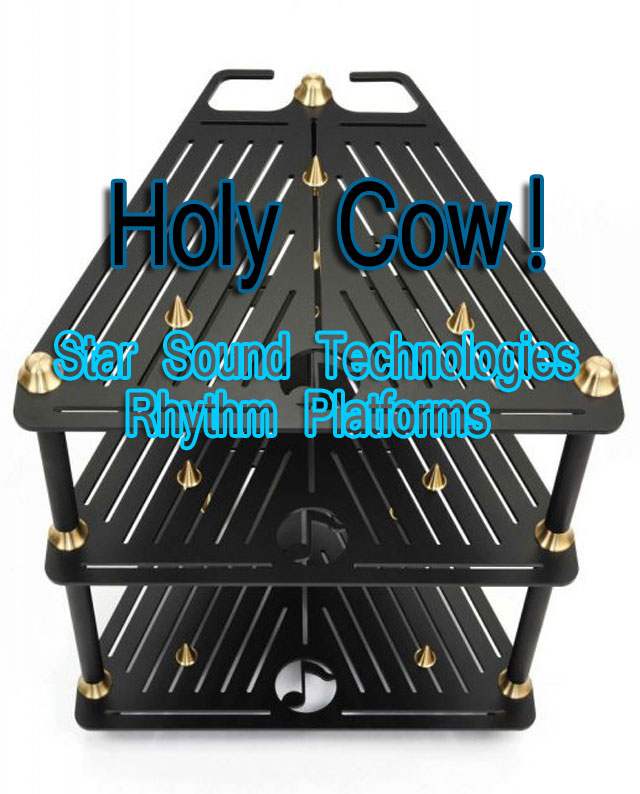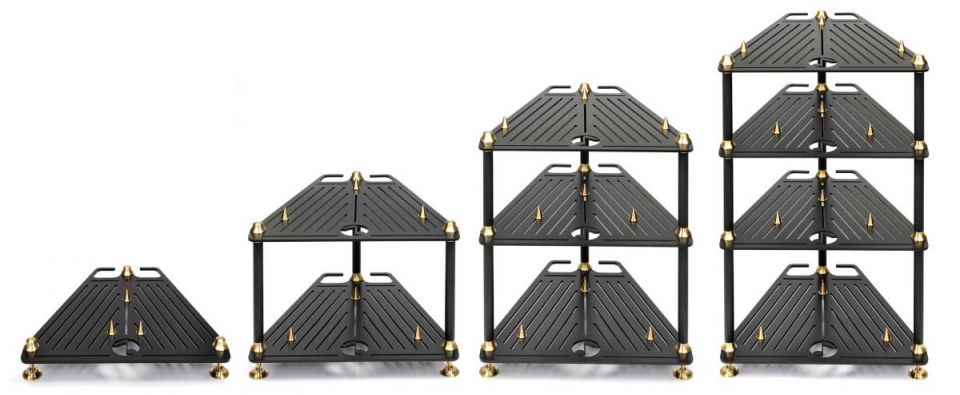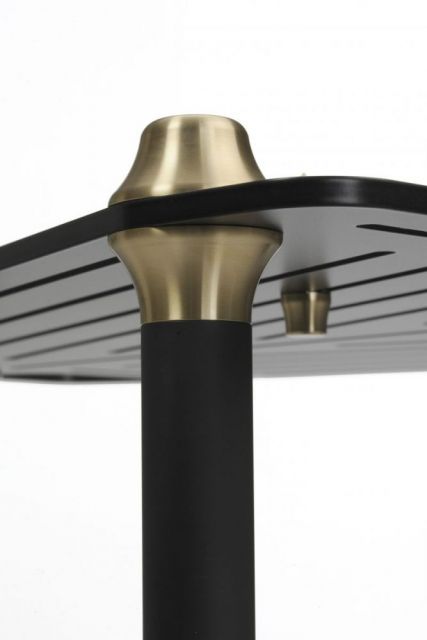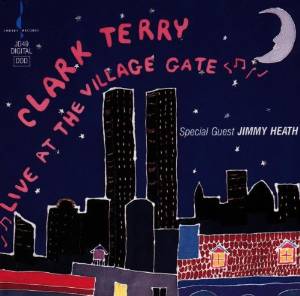Sistrum Rhythm Platforms by Star Sound

One and Four Shelves
 I have had many experiences with improvements in sound quality since I abandoned building cabinets and isolation type devices for myself. Of those I have purchased in the past include: Mana Stands, Nuance shelves, Halcyonic platforms, etc. Certainly, the Star Sound Technologies Rhythm is another major step forward, as was its junior version, the Apprentice. While the Apprentice uses the Audio Points screwed together with a ¼ inch thick steel platform holding them vertically, the Rhythm is more complex with points up Audio Points placed where needed and with brass and steel rods at three corners of each shelf. These three sets of rods terminate at the floor in extra large Audio Point geometry points that are from 2” stock and three inches long. The distance between the shelves is not adjustable other than when buying when one can choose either 8 or 11 Rhythm Rods. I chose a four shelf rack, but this is my review of using only three shelves with all 8 rods, as you can see in the picture.
I have had many experiences with improvements in sound quality since I abandoned building cabinets and isolation type devices for myself. Of those I have purchased in the past include: Mana Stands, Nuance shelves, Halcyonic platforms, etc. Certainly, the Star Sound Technologies Rhythm is another major step forward, as was its junior version, the Apprentice. While the Apprentice uses the Audio Points screwed together with a ¼ inch thick steel platform holding them vertically, the Rhythm is more complex with points up Audio Points placed where needed and with brass and steel rods at three corners of each shelf. These three sets of rods terminate at the floor in extra large Audio Point geometry points that are from 2” stock and three inches long. The distance between the shelves is not adjustable other than when buying when one can choose either 8 or 11 Rhythm Rods. I chose a four shelf rack, but this is my review of using only three shelves with all 8 rods, as you can see in the picture.

The design goal in this rack is the same as the Audio Points from which the rest derive. Electrical, mechanical, and acoustical vibrations, Star Sound argues, they “have discovered mechanical and electronic methods that provide high-speed channels for vibrating resonant energy to locate earth’s ground, maintaining the live, powerful and emotional feel of sound quality to which humans are naturally drawn to, without coloring the resulting experience.” (taken from their web page) Their efforts work!
 The rack is easy to build from the floor up. One merely inserts the big Audio Points into the three corners of the platform into one inch holes and then adds the first set of rods and screws down the rods to support the next up shelf. This then is repeated up to the top shelf, which has brass caps, which are also screwed down. In my case, I used 2.25 inch coupling discs under the big Audio Points. Finally, you place and attach the three 1.5 Audio Points into position for your components. One can use more Audio Points under components, but there are no provisions for raising one that is off the plane of the other three. I also used normal, 1 inch, coupling discs at the top of each point.
The rack is easy to build from the floor up. One merely inserts the big Audio Points into the three corners of the platform into one inch holes and then adds the first set of rods and screws down the rods to support the next up shelf. This then is repeated up to the top shelf, which has brass caps, which are also screwed down. In my case, I used 2.25 inch coupling discs under the big Audio Points. Finally, you place and attach the three 1.5 Audio Points into position for your components. One can use more Audio Points under components, but there are no provisions for raising one that is off the plane of the other three. I also used normal, 1 inch, coupling discs at the top of each point.
I should note that these racks are sold for one shelf up to four shelves. A one shelf amp stand, of course, would have no rods.
Setup
One must consider the space that you need between the platforms or shelves. Star Sound says, “Rhythm rod 8s – provides up to 8.5 inches (21.59cm) of physical component chassis height. This measurement includes the height for the shelf-born Audio Points and Coupling Discs (under the component) and allows for a 1.5 inch (3.81cm) of clearance space at the top of the shelf for ventilation and cosmetic appeal. The exact Length of rod is 11 3/4 inches (29.84cm).” I found that all of my equipment fit using Rhythm rod 8s. Since I got one set of Rhythm rod 11s, and they raised the overall shelf too high off the floor, I returned them and have another set of 8s coming for use to add my fourth shelf.
Nothing was changed in my system; rather the phono stage, digital source, and the Koda K-10 preamp were moved to the Rhythm rack. I had been forewarned that this rack requires settling in and it is true. Given my experience, I would stress this! It was quite bad on the second day but now has proven outstanding with ten days of use.
Listening Experiences
What was most exciting about this rack is its speed. One hears both startling leading edges and the decay of notes. There was no time smearing or roundness of the notes. I fully realize that my other equipment was up to the task of resolving what the rack allowed, but there was just such realism and correctness that I got involved and certainly appreciative of the performances and recording engineer’s success in capturing all of this. Now I got an even more realistic sense of the recording venue. I have learned to greatly appreciate this realism.

Perhaps my deepest impression came from my original copy of Frank Sinatra and Count Basie, “Sinatra at the Sands” (Reprise B0040ND750). I had thought that I had earlier heard all that was on this recording. Not so. On the cut, One For My Baby (and one more for the road), I was shocked to hear suddenly the Sands dining room rather than just Sinatra, the Basie Band, and the audience. All were just there before me and probably better than had I had the best seat in the house. I thought I had this before, but realize now that I didn’t. Perhaps there is still more on recordings or master tapes, but I doubt it.
Time after time I experienced a new sensation with the Rhythm rack, namely the involvement with the musicians and singers on the recordings. A good example was on the third cut on Clark Terry’s “Live At The Village Gate” (Chesky Records, JD49). Paquito D’Rivera joins the band in playing, Silly Samba and the place rocks. I had heard it often before, but never like this! The last cut, Hey, Mr. Mumbles, is also better. I will certainly miss Clark Terry.
 Last night, I finished listening to “The L.A. Four Scores!”, Concord Jazz (CJ-8). What I heard was far superior to what I had heard years ago with my getting involved as though I were there at the recording. I wrote a note saying to add a further note on how transparent and easy the Rhythm made the music. I then heard a weather alert to the effect that we might have a severe storm and totally disconnected my system from the wall. We did have a storm but not a severe one.
Last night, I finished listening to “The L.A. Four Scores!”, Concord Jazz (CJ-8). What I heard was far superior to what I had heard years ago with my getting involved as though I were there at the recording. I wrote a note saying to add a further note on how transparent and easy the Rhythm made the music. I then heard a weather alert to the effect that we might have a severe storm and totally disconnected my system from the wall. We did have a storm but not a severe one.
This afternoon I connected the system and turned everything on. Before listening to the L.A. Four again, I listened to some twenty favorite cuts. Frankly, at first I could not believe what I heard. Every cut had such precision of the instruments’ and singers’ location and such ease that I could envision myself at the performance. On the cut above from Frank Sinatra, I now had a much better seat than anyone there at the actual event.
What happened, you might ask, and I am at a loss to explain it. Perhaps it was turning off the raid system and computer, perhaps the ionization of the storm, or perhaps the Rhythm just breaking in. I hope it was the first or last. I did then listen to the L.A. Four album again, and it was clearly better.
Conclusion
Perhaps I should cease declaring that my music reproduction sounds real, as I seem to be always then adding that something has greatly improved what I hear. Nevertheless, all of the improvements that I have experience in the last several years entail my being as attentive to the performance, as I might be in a great theater hearing top entertainers. There is no longer just background music as the performers might take exception to my inattention.
All that I can conclude about the Star Sound Rhythm rack is that it is phenomenal! I know that I could not achieve what I am hearing now without it. Perhaps, of course, I should also welcome occasional electrical storms. The Rhytm rack is now part of my reference system.
Two things have come up since this was written. Just last weekend I had the opportunity to put two single shelf Rhythm platforms under my monoblocks. As usual with these racks, they needed time to settle. After about two hours three of us concluded that the benefits of the additional platforms under the amps were striking. Last evening with an additional day, it was further improved. The key elements in this improvement are largely speed and detail. Percussion on drums and bells were striking (no pun intended). The decay of notes and the evidence of ambience made one feel present at the recordings. The winds in the LA 4 Scores! were quite evident and their chatter like being among them.
Others have told me that I would have gotten greater improvement putting the Rhythm platforms under my speakers. With 198 pound per side speakers, I will need additional help to try this.
Finally, just this weekend, I got six of the larger coupling cups (APCD3s) to be used to the floor. The rack has always been on them, but the platforms under the monoblocks have been on the small coupling cups. I replaced them with the new 2 ½ inch cups and turned on the system. I just was not prepared for the shocking improvement I heard. Ironically, I chose the Clark Terry Silly Samba piece and the horns were just effortless and sharp as were they before me. I really don’t know how much better music reproduction can get!


norm luttbeg
Specifications:
Sistrum Rhythm single platform model RP1: $1450
Sistrum Rhythm double platform model RP2: $2800
Sistrum Rhythm triple platform model RP3: $4200
Sistrum Rhythm four platform model RP4: $5500
Star Sound Technologies
1542 North 24th St.
Allentown, PA 18104
Phone: (877) 668-4332
Email: sales@starsoundaudio.com
Webpage: www.audiopoints.com
Stereo Times Masthead
Publisher/Founder
Clement Perry
Editor
Dave Thomas
Senior Editors
Frank Alles, Mike Girardi, Russell Lichter, Terry London, Moreno Mitchell, Paul Szabady, Bill Wells, Mike Wright, and Stephen Yan,
Current Contributors
David Abramson, Tim Barrall, Dave Allison, Ron Cook, Lewis Dardick, John Hoffman, Dan Secula, Don Shaulis, Greg Simmons, Eric Teh, Greg Voth, Richard Willie, Ed Van Winkle, Rob Dockery, Richard Doran, and Daveed Turek
Site Management Clement Perry
Ad Designer: Martin Perry






Be the first to comment on: Sistrum Rhythm Platforms by Star Sound